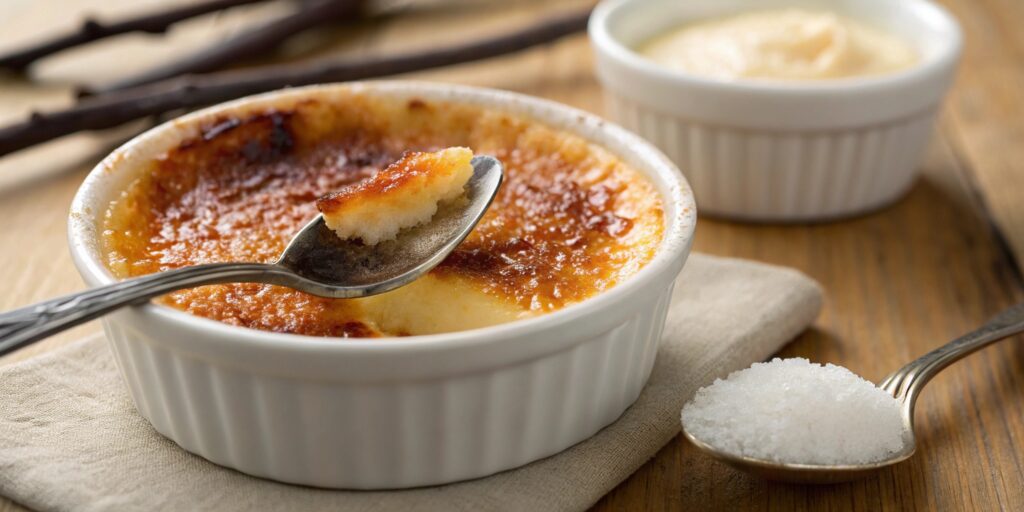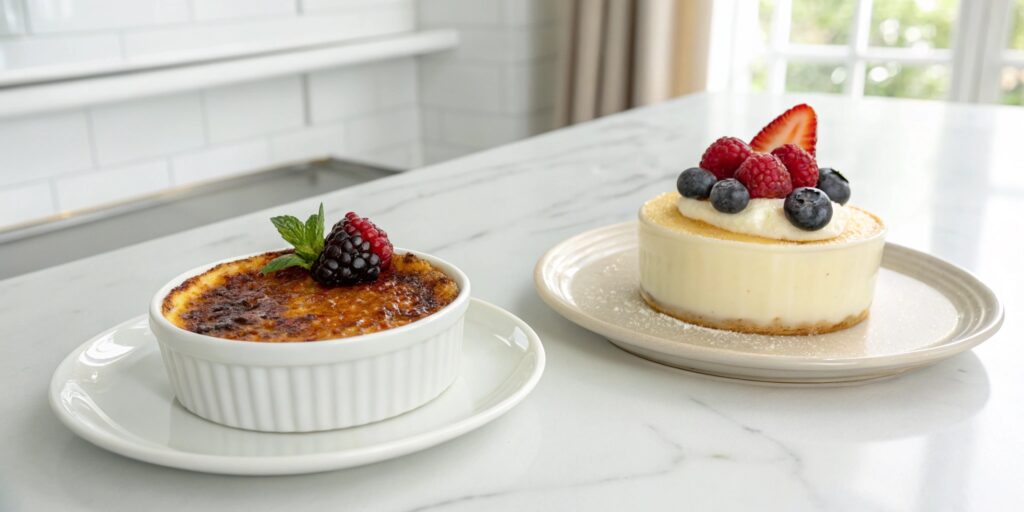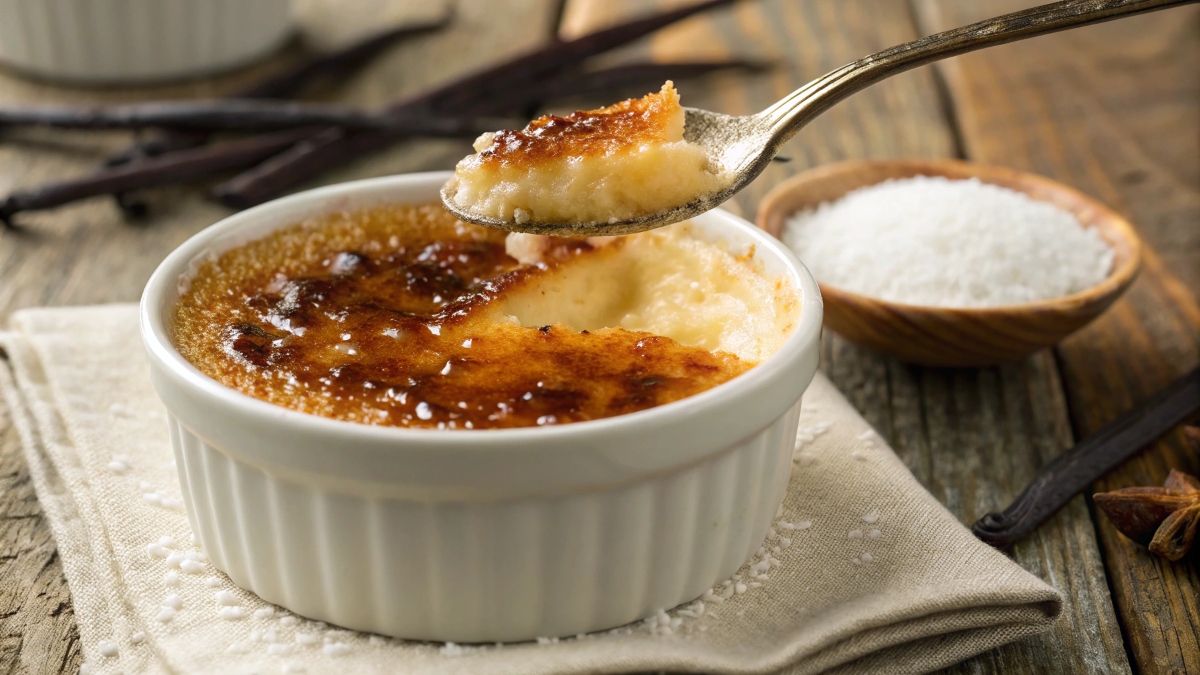When thinking about creamy and delicious desserts, both crème brûlée and custard often come to mind. However, have you ever stopped to ask yourself: what’s the difference between crème brûlée and custard? 🍮 While they both share a rich and velvety texture, as well as similar ingredients, they do have distinct characteristics that set them apart. Therefore, this article will dive into their key differences, including texture, preparation methods, and taste.
📌 Table of Contents
- What is Crème Brûlée?
- What is Custard?
- The Origins of Crème Brûlée and Custard
- Key Differences Between Crème Brûlée and Custard
- Why Do People Confuse Crème Brûlée and Custard?
What is Crème Brûlée? 🍮

Crème brûlée is a well-known French dessert that stands out due to its luxuriously creamy texture and iconic caramelized sugar topping. Notably, the name translates to “burnt cream” in French, which refers to the crisp, caramelized layer created by torching sugar on top.
✨ Key Ingredients of Crème Brûlée
- Heavy cream
- Egg yolks
- Granulated sugar
- Vanilla extract
During preparation, the custard base is baked in a water bath and then thoroughly chilled. Afterward, just before serving, sugar is evenly sprinkled on top and caramelized using either a torch or a broiler. As a result, this process creates a delightful contrast between the silky custard below and the crisp topping above.
What is Custard?
Unlike crème brûlée, custard is a broad category of desserts that encompasses various types, such as pudding and flan. Essentially, it is made by combining milk or cream with eggs and sugar, then cooking the mixture gently to create a smooth and luscious consistency.
🍮 Common Types of Custard
- Baked Custard: Cooked in the oven, often resulting in a firm texture.
- Stirred Custard: Cooked on the stovetop, typically used for fillings or sauces.
- Frozen Custard: A creamier and denser alternative to traditional ice cream.
The Origins of Crème Brûlée and Custard
Both crème brûlée and custard have a long-standing history in European cuisine. In fact, custard dates back to medieval times, where it was frequently used in pies and pastries. Meanwhile, crème brûlée is believed to have originated in 17th-century France. However, similar variations, such as Trinity Cream from England and Crema Catalana from Spain, suggest that the dish’s origins may be more complex.
Key Differences Between Crème Brûlée and Custard
Although they share many ingredients, there are several notable differences between crème brûlée and custard:
| Feature | Crème Brûlée | Custard |
|---|---|---|
| Texture | Rich and silky with a crunchy caramelized top | Smooth and thick, varying from soft to firm |
| Cooking Method | Baked in a water bath, then torched | Cooked on the stovetop or baked |
| Topping | Caramelized sugar crust | Plain or garnished (no burnt sugar layer) |
| Common Uses | Typically served as an elegant dessert | Often used in pies, pastries, and sauces |
🥄 Texture: Smooth or Creamy?
When it comes to texture, crème brûlée has a denser and more luxurious mouthfeel, mainly due to the use of heavy cream and egg yolks. In contrast, custard varies in texture—sometimes softer, sometimes firmer—depending on the ratio of eggs to liquid.
🧂 Ingredients: What’s Inside Each Dessert?
One primary difference between these desserts lies in the fat content. Specifically, crème brûlée contains more cream and egg yolks, which results in a richer, more indulgent texture. On the other hand, custard can be made with milk, making it considerably lighter.
🔥 Cooking Methods: Baking vs. Stovetop
Unlike custard, crème brûlée is always baked in a water bath to achieve a creamy consistency. In contrast, custard can either be baked or cooked on the stovetop, depending on the desired outcome.
🍽️ Presentation & Appearance
Perhaps the most obvious distinction is the signature caramelized top of crème brûlée. To achieve this, sugar is evenly sprinkled over the custard and torched to form a crisp, golden-brown crust. Meanwhile, custard is typically served plain or topped with garnishes such as fruit or whipped cream.
Why Do People Confuse Crème Brûlée and Custard?
Because crème brûlée is technically a baked custard, it is understandable why many people confuse the two. However, the defining elements that distinguish crème brûlée include its crispy burnt sugar topping and its significantly richer consistency.
Looking for a classic crème brûlée recipe? If so, try this simple guide to make a perfect batch at home! 🍮
How Crème Brûlée is Made
To achieve its creamy interior and crispy caramelized top, crème brûlée requires careful preparation. Not only does the baking process ensure a delicate custard texture, but the final sugar caramelization also adds a satisfying crunch.
📝 Step-by-Step Guide to Making Crème Brûlée
- Prepare the custard base: First, heat heavy cream and vanilla until warm, then gradually whisk into egg yolks and sugar.
- Strain for smoothness: Next, pass the mixture through a fine sieve to eliminate air bubbles.
- Bake in a water bath: Then, pour the custard into ramekins and place them in a baking dish filled with hot water.
- Chill before serving: After baking, refrigerate for several hours to allow the custard to set.
- Caramelize the sugar topping: Finally, sprinkle sugar over each custard and use a torch to create a golden, crisp layer.
💡 Curious about the secret of crème brûlée? Discover expert techniques for achieving the perfect texture!
The Secret Behind the Perfect Caramelized Sugar Top 🔥
The brûlée effect is achieved by caramelizing sugar with an open flame. Consequently, this process creates the dessert’s iconic contrast between its smooth custard and crisp topping.
🔥 Best Methods to Caramelize Sugar
- Using a kitchen torch: This is the best and most precise method for even caramelization.
- Oven broiling: Alternatively, place ramekins under the broiler for a few minutes.
- Hot spoon method: Heat a metal spoon and press it onto sugar until caramelized.
💡 Don’t have a crème brûlée torch? Try these alternatives for achieving the perfect caramelized top!
How Custard is Made
Unlike crème brûlée, custard is more versatile because it can be cooked on the stovetop or baked. Furthermore, the chosen cooking method significantly influences its final texture.
🥄 How to Make Classic Custard
- Whisk together eggs, sugar, and milk: This step forms the base of most custards.
- Gently heat on the stovetop: Stir constantly to prevent curdling and achieve a thickened consistency.
- For baked custard: Pour the mixture into dishes and bake in a water bath.
- Chill before serving: While some custards are served warm, others benefit from refrigeration.
🍮 Classic Baked Custard vs. Stovetop Custard
| Type | Cooking Method | Texture |
|---|---|---|
| Baked Custard | Cooked in the oven using a water bath | Firm, sliceable texture |
| Stovetop Custard | Slowly cooked over medium heat | Smooth, pourable consistency |
Can You Turn Custard into Crème Brûlée?
Many people wonder if they can simply add a caramelized sugar topping to custard and call it crème brûlée. While the two desserts share similarities, true crème brûlée has a richer texture due to its higher cream content.
🔥 DIY Caramelized Topping for Custard
If you want to transform custard into crème brûlée, follow these simple steps:
- Chill the custard: Ensure it is fully set and cold.
- Add sugar: Evenly sprinkle a thin layer of white sugar on top.
- Caramelize: Use a kitchen torch or broiler to create a crispy caramelized layer.
What Can You Use Instead of Ramekins for Crème Brûlée?
Traditionally, crème brûlée is made in shallow ramekins to allow for an evenly caramelized top. However, if ramekins are unavailable, you can use:
- Shallow oven-safe bowls: Just make sure they can withstand high temperatures.
- Coffee cups or teacups: Although deeper than ramekins, they still work.
- Glass jars: Some heat-resistant jars can also be used for baking.
💡 Explore these alternatives for making crème brûlée without traditional ramekins.
Popular Variations of Crème Brûlée & Custard
Over time, both crème brûlée and custard have been adapted worldwide, leading to many delicious variations.
🍫 Flavored Crème Brûlée: Vanilla, Chocolate, & More
Although classic crème brûlée is flavored with vanilla, chefs frequently experiment with:
- Chocolate crème brûlée: A rich and decadent variation using melted dark chocolate.
- Matcha crème brûlée: Infused with green tea for a subtly bitter flavor.
- Coffee crème brûlée: Perfect for coffee lovers seeking a bold twist.
🍮 Custard-Based Desserts: Pudding, Flan, and More
Custard serves as the foundation for many beloved desserts, including:
- Flan: A caramel-topped custard that is particularly popular in Spanish cuisine.
- Pudding: A softer, milk-based custard variation.
- Pastry cream: Commonly used for filling éclairs and tarts.
Ultimately, whether you prefer the burnt sugar crunch of crème brûlée or the smooth versatility of custard, both desserts offer indulgent flavors that can be customized in countless ways.
How Do Crème Brûlée and Custard Taste?
One of the biggest factors that set crème brûlée and custard apart is their taste. While both are sweet and creamy, their textures and depth of flavor create a different dessert experience.
🥄 Sweetness & Creaminess: Which One is Richer?
Crème brûlée has a deep, caramelized sweetness due to the burnt sugar topping, which balances the richness of the custard underneath. The use of heavy cream and egg yolks gives it a denser texture.
Custard, depending on its preparation, tends to have a milder sweetness. Since it often uses milk instead of cream, it is usually lighter in taste and texture.
🍽️ Which One Has a More Intense Flavor?
The key to a flavorful crème brûlée lies in its vanilla-infused custard and contrast between the smooth texture and the crunchy caramelized top. Custard, on the other hand, absorbs flavors easily, making it more adaptable for different recipes like crab brûlée or fruit-infused versions.
Nutritional Comparison: Which is Healthier?

Although both desserts are indulgent, there are slight differences in their nutritional value. Here’s a comparison:
| Feature | Crème Brûlée (per serving) | Custard (per serving) |
|---|---|---|
| Calories | 300-350 kcal | 150-200 kcal |
| Sugar | 25-30g | 15-20g |
| Fat | 20-25g | 8-12g |
| Protein | 5-7g | 4-6g |
🧐 Sugar & Fat Content: Is One Healthier?
Since crème brûlée is made with heavy cream and egg yolks, it has a higher fat content compared to custard. Additionally, the caramelized sugar topping adds more sugar. Custard, especially when made with milk instead of cream, is the lighter option.
💡 Can You Make a Healthier Version of Either?
Yes! Here are some simple ways to create a healthier version of each dessert:
- For crème brûlée: Use coconut milk instead of heavy cream and a sugar substitute for caramelization.
- For custard: Reduce sugar and opt for low-fat or plant-based milk.
Frequently Asked Questions About Crème Brûlée and Custard
What is the Secret of Crème Brûlée?
The key to perfect crème brûlée is slow baking and precise caramelization. Here are some expert tips:
- Use a low-temperature baking technique to prevent overcooking.
- Ensure your water bath reaches halfway up the ramekins for even cooking.
- Let the crème brûlée chill for at least 4 hours before caramelizing.
Is Custard Always Soft, or Can It Be Firm?
Custard can range from silky and soft to firm and sliceable, depending on the egg-to-liquid ratio. Baked custards, like flan, are firmer, while stovetop custards remain softer.
Why Does My Crème Brûlée Turn Out Runny?
A runny crème brûlée is often the result of undercooking or improper chilling. To fix this issue:
- Ensure the custard reaches an internal temperature of at least 160°F.
- Chill for at least 4 hours (overnight for best results).
- Use fresh egg yolks for the best consistency.
How Long Can Crème Brûlée and Custard Be Stored?
Both desserts can be stored in the refrigerator:
- Crème brûlée: Up to 3 days before caramelizing the top.
- Custard: Up to 4 days, covered to prevent drying.
Can You Make These Desserts in Advance?
Yes! You can prepare both crème brûlée and custard a day ahead. For crème brûlée, store the custard in the refrigerator and caramelize the sugar just before serving.
Conclusion: Which One Should You Try?
Whether you prefer the creamy elegance of crème brûlée or the versatility of custard, both desserts offer unique flavors and textures.
💡 If you love a luxurious dessert with a crispy top, go for crème brûlée! But if you enjoy a smoother, lighter treat, custard is a great option.
📌 Looking to try your own homemade version? Check out our crème brûlée recipe and experiment with different flavors!

